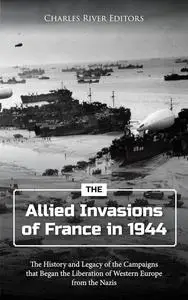The Allied Invasions of France in 1944: The History and Legacy of the Campaigns that Began the Liberation of Western Europe from the Nazis by Charles River Editors
English | December 26, 2023 | ISBN: N/A | ASIN: B0CR1RMR17 | 154 pages | EPUB | 15 Mb
English | December 26, 2023 | ISBN: N/A | ASIN: B0CR1RMR17 | 154 pages | EPUB | 15 Mb
During World War II, the free world literally hung in the balance, with the Axis and Allies engaging in warfare on an unprecedented scale. Although Hitler’s Nazi Germany had overrun much of the European continent by 1940, the Allies began to reverse the momentum in 1942. By the end of 1943, with Allied forces firmly established in Italy and the Soviets on the verge of turning the tide in Russia, the British and Americans began to plot the invasion that would liberate Europe from the Nazis.
By the end of D-Day, the Allies had managed to successfully land 170,000 men, including over 75,000 on the British and Canadian beaches, 57,000 on the American beaches, and over 24,000 airborne troops. Thanks to Allied deception, the German army had failed to react to prevent the Allies from making the most of their landings. Just one division, the Hitlerjugend, would arrive the following day. Despite a fearsome and bloody day, the majority of the Allied forces had held their nerve, and most importantly, achieved their objectives. This ensured Operation Overlord was ultimately successful, and victory in Europe would be achieved within less than a year.
Churchill was not overstating the achievements of the invasionwhen he described the plan “the greatest thing we have ever attempted”. The greatest armada the world had ever seen had landed 170,000 soldiers on the heavily defended beaches of Normandy in just 24 hours. More remarkable was the fact that the operation was a success on every major level. Deception, tactical surprise and overwhelming force had contributed to the establishment of an adequate beachhead. Confusion and dissent had stopped the Germans massing for any great counterattack. The Atlantic Wall which Hitler had placed so much faith in had been breached, and the race to Paris was on. Operation Overlord aimed to have the Allies reach the Seine River within 3 months of D-Day, and it’s a testament to the men who fought and served on D-Day that the goal was reached early.
While D-Day is one of the most famous events of the war, it is widely overlooked that about two months after the landings in Normandy, there was a second Allied landing in France. On August 15, 1944, a combined US-French force landed in southern France on the beaches of the Côte d'Azur as part of Operation Dragoon. In just over four weeks of fighting, the Allied landing led to the liberation of most of southern France and to one of the most audacious and successful Allied operations of World War II.
However, the planning that led to Operation Dragoon (originally named Operation Anvil) was anything but settled. The idea for a landing in the south of France had been raised by senior commanders as early as 1942, and at one time it was intended to be a concurrent operation with the Overlord landings in Normandy. However, the spectacular failure of the American landing at Anzio in Italy earlier in the year and an increase in the size of forces for Overlord meant there simply weren’t resources to spare for a second simultaneous landing in France. Thus, Operation Anvil was canceled.
The landings in Normandy and the campaign that followed were successful, but that very success brought its own problems. As the huge Allied armies advanced far beyond the original invasion beaches, providing them with critical supplies such as food, fuel, and ammunition became difficult. The farther they advanced into France, the more acute this problem became, and the failure to capture the port of Cherbourg on schedule made the situation worse.



